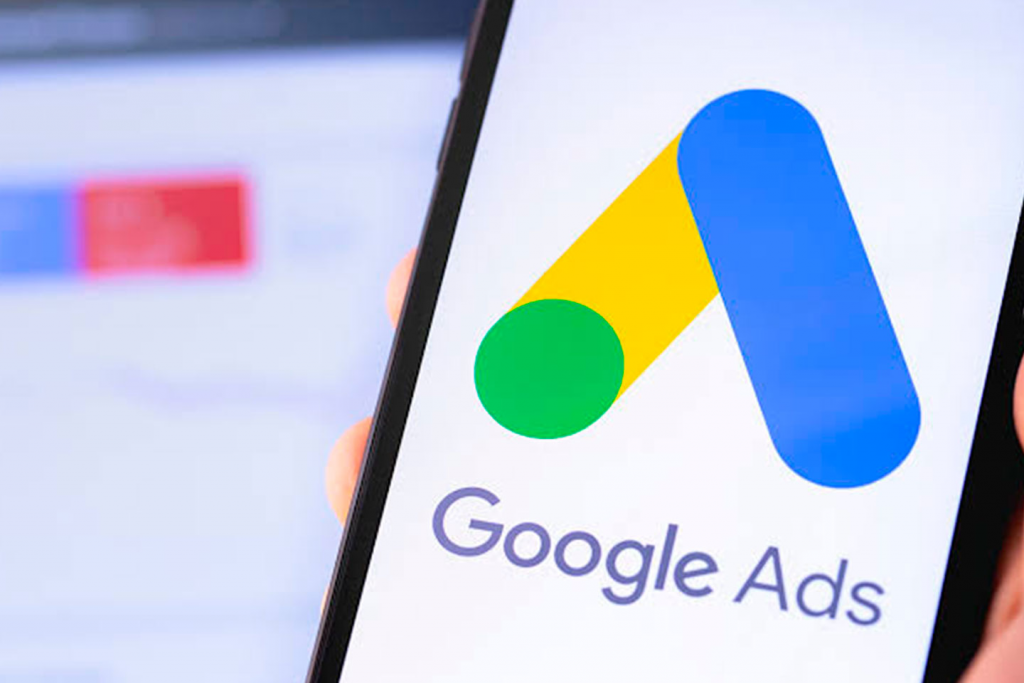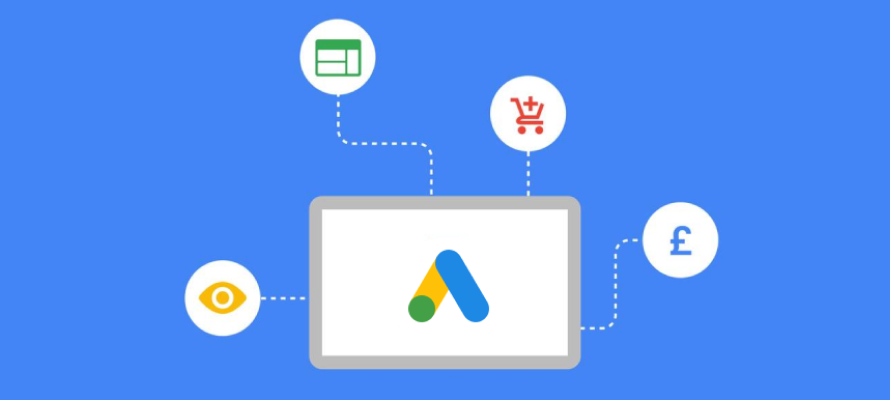In the dynamic realm of online advertising, mastering a Google Ads strategy is crucial for businesses aiming to stand out amidst fierce competition. Whether you’re new to the Google Ads ecosystem or looking to refine your existing approach, understanding the intricacies of Google Ads campaigns, ad groups, and various ad types is the key to unlocking unparalleled success in the digital landscape.
This article is a segment of a more extensive piece about Google Ads Optimization.
What is Google Ads?

Google Ads, formerly Google AdWords, is the cornerstone of online advertising, offering businesses an unparalleled platform to connect with a vast audience across the expansive Google network. Using a pay-per-click (PPC) model, Google Ads allows businesses to bid on specific keywords relevant to their products or services. When users search using these keywords, ads from participating businesses appear prominently on the search engine results page (SERP). This auction-based system ensures that businesses only pay when users click on their ads, making it a cost-effective and measurable advertising solution.
The versatility of Google Ads extends beyond traditional search ads, encompassing various formats, including image ads, video ads, and app promotion ads. This flexibility enables businesses to engage with their target audience through visually compelling content, fostering brand awareness and driving conversions.
Additionally, Google Ads extends its reach to the Google Display Network (GDN), allowing advertisers to showcase their products on a vast network of websites, blogs, and apps. As we delve into the realm of Google Ads strategy, understanding its foundational principles is essential to harnessing its full potential for business growth and online visibility.
Why are Google Ads Strategies Important?

In the ever-evolving digital marketplace, where Google Search reigns supreme, a well-crafted Google Ads strategy can be the linchpin that differentiates success from obscurity. Let’s delve into why these strategies are indispensable for businesses seeking to navigate the complexities of online advertising effectively.
Adaptability to Google’s Algorithms
Google Ads strategies empower advertisers to stay ahead of the curve by adapting to the frequent changes in Google’s algorithms. Keeping pace with updates ensures that your campaigns remain optimized for the latest features, maximizing their effectiveness. 80% of businesses across the globe trust paid Google Ads for their PPC campaigns.
Precise Targeting for Relevant Traffic
Crafting a Google Ads campaign involves meticulously selecting keywords and targeting options. By honing in on your target audience through careful consideration of relevant keywords, you can attract high-quality traffic to your website, increasing the likelihood of conversions. 33% of people click on search ads because of how relevant the ad is to their search.
Optimized Budget Allocation
One of the most critical aspects of a successful Google Ads strategy is efficient ad spend allocation. Through strategic planning and continuous monitoring, businesses can avoid wasting resources on irrelevant clicks and focus on channels that generate the most conversions. Businesses can automate budget allocation and spending in a budget plan.
Strategic Use of Ad Types
Knowing how and when to use each is pivotal with many ad types. From engaging search ads to visually captivating display ads, a well-rounded strategy considers the diverse needs of your target audience and tailors ad types accordingly. 85.3% of all its clicks come from paid Google Shopping or Google Ads campaigns.
Conversion Tracking for Measurable Results
Google Ads conversion tracking is the heartbeat of your advertising efforts. Understanding how users interact with your ads and their actions on your landing pages allows for data-driven decisions, enabling you to refine your strategy for optimal performance. Google Ads provides comprehensive tracking and reporting tools to measure the performance of campaigns.
As we delve deeper into the intricacies of Google Ads strategies, it becomes evident that a well-crafted approach is not merely a luxury but a necessity in today’s fiercely competitive digital landscape. Whether you are a seasoned advertiser or just starting, honing your Google Ads strategy is the key to unlocking the full potential of your online presence. Join us as we explore the nuances of creating effective ad campaigns, optimizing bids, and leveraging the power of Google Ads for unparalleled success.
Crafting Effective Strategies with Google Ads

In the fast-paced world of digital marketing, a well-defined strategy is the cornerstone of success, and Google Ads is a powerful ally in reaching and engaging with your target audience. Elevating your marketing game with Google Ads involves a strategic approach encompassing various elements, from keyword selection to ad design and optimization. Here’s a comprehensive guide to help you craft a winning marketing strategy using Google Ads
Define Clear Objectives: Begin by outlining your marketing objectives. Whether it’s increasing brand awareness, driving website traffic, or boosting product sales, having clear goals will shape the rest of your strategy and guide your campaign structure.
Thorough Keyword Research: Identify and target the most relevant keywords for your business. Utilize tools like Google Keyword Planner to uncover high-traffic keywords related to your products or services. Consider long-tail keywords for more precise targeting and potentially lower competition.
Strategic Campaign Structure: Organize your campaigns into well-defined ad groups. This allows for more granular control over your ads and enables you to tailor messaging to specific audience segments. Align your ad groups with the products, services, or themes you want to promote.
Compelling Ad Copy and Design: Craft persuasive ad copy that speaks directly to your target audience. Highlight unique selling propositions, promotions, or special offers. Ensure consistency between your ad copy and the landing page to provide a seamless user experience. Experiment with different ad formats, including responsive search ads, to find what resonates best with your audience.
Utilize Ad Extensions: Enhance your visibility and relevance by incorporating ad extensions. These additional snippets of information, such as site links, callouts, and location extensions, provide users with more details about your business and increase the likelihood of clicks.
Leverage Targeting Options: Refine your audience targeting based on demographics, location, interests, and behaviors. Use remarketing to re-engage users who have previously visited your website. Experiment with custom and lookalike audiences to expand your reach to users with characteristics similar to your existing customer base.
Conversion Tracking and Analytics: Implement conversion tracking to measure the success of your campaigns. Analyze key metrics such as click-through rates, conversion rates, and return on ad spend. Use this data to refine your strategy, allocating budget and resources to the most effective campaigns and keywords.
Smart Bidding Strategies: Explore Google Ads’ smart bidding options, such as target CPA (cost per acquisition) or maximize conversions. These automated bidding strategies leverage machine learning to optimize your bids and maximize the likelihood of achieving your goals.
Mobile Optimization: Given the increasing prevalence of mobile users, ensure your campaigns are optimized for mobile devices. Responsive ads and mobile-specific ad creatives provide a seamless experience for users on smartphones and tablets.
Continuous Testing and Optimization: Digital marketing is an iterative process. Regularly test different ad variations, keywords, and targeting options to identify what resonates best with your audience. Use A/B testing to refine your approach and allocate budget to the most successful elements of your campaigns.
By combining these strategic elements, your Google Ads campaigns can potentiate your overall marketing strategy. As the digital landscape evolves, staying adaptable and data-driven will ensure that your advertising efforts on Google Ads remain effective and aligned with your business goals.
Mastering Success with Smart Bidding Strategies in Google Ads

In the dynamic realm of online advertising, Google Ads’ Smart Bidding Strategies have merged as a game-changer, empowering advertisers to optimize their campaigns with a level of precision and efficiency previously unseen. These automated bidding strategies leverage advanced machine learning algorithms to tailor bids for each auction, maximizing the likelihood of achieving specific campaign goals. Let’s delve into the key aspects and benefits of Smart Bidding, unraveling how it can elevate your Google Ads performance.
Understanding Smart Bidding
Smart Bidding harnesses the power of machine learning to analyze vast datasets and make real-time bidding decisions. By considering a multitude of factors such as device, location, time of day, and user behavior, Smart Bidding adapts bids to align with the likelihood of a conversion. It eliminates the need for manual bid adjustments and allows advertisers to focus on strategic aspects of campaign management.
Key Smart Bidding Strategies
Target CPA (Cost Per Acquisition): This strategy aims to maximize conversions at a predefined target cost. Advertisers set a specific cost per acquisition they are willing to pay, and Smart Bidding adjusts bids to meet this goal. Ideal for businesses focused on driving conversions while maintaining a specific cost threshold.
Target ROAS (Return On Ad Spend): For advertisers prioritizing revenue generation, Target ROAS focuses on optimizing bids to achieve a specific return on ad spend. This strategy is particularly valuable for e-commerce businesses seeking a balance between high revenue and efficient ad spend.
Maximize Conversions: The Maximize Conversions strategy optimizes bids to generate as many conversions as possible within a budget. Ideal for advertisers looking to maximize their campaign’s conversion volume without setting specific cost constraints.
Maximize Clicks: For those prioritizing website traffic over conversions, Maximize Clicks automatically adjust bids to drive as many clicks as possible within the specified budget. This strategy is useful for increasing overall visibility and website visits.
Enhanced Cost Per Click (eCPC): eCPC is a flexible strategy that allows advertisers to retain some manual control over bidding. Smart Bidding automatically adjusts bids for clicks that seem more likely to result in conversions, optimizing performance while providing a degree of customization.
Benefits of Smart Bidding
Efficiency and Time Savings: Smart Bidding eliminates the need for constant manual bid adjustments, allowing advertisers to focus on strategic aspects of campaign management. This efficiency is particularly beneficial for businesses with limited resources.
Real-Time Adaptability: With machine learning algorithms analyzing user behavior and auction dynamics in real-time, Smart Bidding ensures that bids are dynamically adjusted to maximize performance based on current conditions.
Data-Driven Decision Making: Leveraging vast datasets, Smart Bidding strategies make informed decisions, optimizing bids based on historical performance and user signals. This data-driven approach contributes to more accurate predictions and improved campaign outcomes.
Goal Alignment: Whether the goal is to drive conversions, maximize revenue, or increase clicks, Smart Bidding allows advertisers to align their bidding strategy precisely with their overarching campaign objectives.
In conclusion, Smart Bidding Strategies in Google Ads represent a paradigm shift in the landscape of digital advertising. By harnessing the power of machine learning, advertisers can achieve unprecedented levels of efficiency, precision, and performance optimization. Whether aiming to drive conversions, boost revenue, or maximize clicks, integrating Smart Bidding into your Google Ads strategy can propel your campaigns to new heights in the ever-evolving world of online advertising.
Effective Google Ads Strategies for Diverse Business Models

Google Ads offers a versatile platform for businesses of all types to reach their target audience, drive conversions, and increase sales. Whether you’re a small business, an e-commerce site, a B2B company, or focusing on marketing and lead generation, Google Ads can be tailored to meet your unique needs. Here’s how different business models can leverage Google Ads to their advantage:
Small Business
Small businesses can benefit greatly from Google Ads by focusing on local targeting and optimizing for keywords relevant to their niche. Using smart campaigns and targeting specific geographic locations can help these businesses appear in Google search results without competing against larger companies with bigger ad spending. Responsive display ads and search campaigns can effectively reach potential customers while maintaining a controlled daily budget, ensuring they avoid wasting ad spend. Incorporating negative keywords and monitoring their quality score also helps refine ad campaigns for better performance. 65% of small-to-midsize businesses have a PPC campaign.
Example: Local Tech Repair Shop
Strategy: Focusing on local targeting in Austin for tech repair services.
Key Tactics:
- Smart Campaigns: Utilizing automated ad placements for efficient targeting.
- Local Keywords: Optimizing for keywords like “quick laptop repair” and “phone screen fix Austin.”
- Responsive Display Ads: Showcasing quick repair services with a strong call-to-action.
- Budget Control: Maintaining a daily budget to avoid overspending.
- Quality Score Monitoring: Regularly checking and optimizing quality scores for better ad performance.
E-Commerce
E-commerce businesses thrive on shopping ads and targeted campaigns that showcase their products directly in Google search results and on the Google Display Network. These businesses can use Google Ads conversion tracking to monitor which ads lead to purchases and adjust their strategy accordingly. Creating visually appealing responsive display ads and optimizing landing pages ensure a seamless shipping experience. Target CPA bidding and smart campaigns can help maximize ROI while shopping campaigns tailored towards Google users ready to purchase can significantly increase sales. Google Shopping Ads have an average conversion rate of 1.91%. The average click-through rate (CTR) for Google Shopping Ads is 0.86%.
Example: Online Tech Gadgets Retailer
Strategy: Leveraging shopping ads and targeted campaigns for tech products.
Key Tactics:
- Conversion Tracking: Utilizing Google Ads conversion tracking to understand purchase behavior.
- Visually Appealing Ads: Creating responsive display ads with high-quality images and compelling copy.
- Optimized Laning Pages: Ensuring seamless shopping experiences with well-optimized product pages.
- Target CPA Bidding: Maximizing ROI by setting target cost per acquisition for efficient ad spend.
- Google User Targeting: Tailoring shopping campaigns for users with high purchase intent.
B2B
For B2B companies, Google Ads works best when focused on generating leads. This involves creating ads that speak directly to other businesses’ needs and challenges. Utilizing LinkedIn integration through Google Ads can also be beneficial. Focusing on search queries and keywords pacific to the B2B market and employing call extensions can improve engagement. B2B companies should optimize their landing pages for lead generation, offering whitepapers or webinar sign-ups to collect business leads. According to Google Ads Benchmarks for B2B Companies, the median number of Impressions in September 2023 was 31.09K. The median number of Clicks for Google Ads for B2B Companies was also significant.
Example: Cloud Computing Solutions Provider
Strategy: Focused on generating B2B leads for cloud computing services.
Key Tactics:
- Business-Centric Ads: Creating ads addressing B2B needs and challenges in cloud solutions.
- LinkedIn Integration: Leveraging LinkedIn integration through Google Ads for enhanced B2B targeting.
- Call Extensions: Encourage direct engagement with the inclusion of call extensions.
- Lead-Optimized Landing Pages: Designing landing pages optimized for lead generation, offering white papers and webinar sign-ups.
- B2B Keyword Focus: Targeting specific B2B keywords to improve relevance.
Marketing
Businesses focusing on marketing need to use Google Ads to build brand awareness, as online ads increase brand awareness by 80%. Video campaigns, especially on YouTube channels, can be very effective. Performance Max campaigns allow businesses to reach potential customers across Google’s entire inventory, including YouTube, Google Play, and the Google Display Network. Utilizing data segments and crafting ad copy that resonates with the target audience helps create a strong brand presence. Additionally, using Google Ads to drive traffic to insightful blog posts or web pages can establish a business as a thought leader in its field.
Example: Digital Marketing Agency
Strategy: Building brand awareness and thought leadership through Google Ads.
Key Tactics:
- Video Campaigns: Showcasing success stories and services through engaging video campaigns on YouTube channels.
- Performance Max Campaigns: Extending reach across Google’s entire inventory, including YouTube, Google Play, and the Google Display Network.
- Data Segment Utilization: Using data segments to refine targeting and resonate with specific audience segments.
- Ad Copy Craftsmanship: Creating compelling ad copy that resonates with the target audience and highlights the agency’s strengths.
- Content-Driven Traffic: Driving traffic to insightful blog posts or web pages to establish thought leadership.
Lead Generation
Lead generation strategies focus on capturing information from interested users. Google Ads can be highly effective by targeting the right keywords and creating compelling ad copy that encourages a specific action. App ad campaigns and call extensions can drive phone calls, while targeted landing pages with clear calls to action can collect user information for follow-up. Using conversion tracking, businesses can fine-tune their campaigns for the best results, ensuring a higher conversion rate and quality leads. On average, you’re likely to see a 25% increase in conversion volume for the same CPA/ROAS.
Example: SaaS Provider for CRM Solutions
Strategy: Capturing information from businesses interested in CRM solutions.
Key Tactics:
- High-Intent Keywords: Targeting high-intent keywords for CRM software to capture a relevant audience.
- Compelling Ad Copies: Crafting app campaigns with clear calls to action for demo sign-ups or free trials.
- App Campaigns and Call Extensions: Utilizing app ad campaigns and call extensions to drive phone calls and interactions.
- Targeted Landing Pages: Designing landing pages specifically for lead capture with clear calls to action.
- Conversion Tracking: Fine-tuning campaigns with conversion tracking for higher conversion rates and quality leads.
Google Ads provides a powerful platform for various business models with distinct strategies and goals. By carefully crafting campaigns, selecting the right keywords, and creating targeted ads, businesses can use Google Ads to increase visibility, drive sales, generate leads, and build their brand. With smart bidding strategies and continuous optimization, these ads can offer valuable opportunities for growth and success.
Conclusion
In conclusion, establishing a successful presence on Google Ads begins with strategically creating a Google Ads account, where advertisers meticulously craft ad campaigns and ad groups to target specific audiences and drive impactful results. Utilizing the power of Google Ads, businesses can create compelling ads that resonate with their target audience, optimizing landing pages to ensure a seamless user experience and leading to more website sales. Selecting the right keyword phrases is paramount, as advertisers bid strategically to secure ad placements on the search network, identifying which keywords generate the most valuable website visitors.
To navigate this dynamic landscape effectively, businesses must create ads and constantly refine their approach, whether through blog posts, keyword bids, or engaging YouTube channels that foster a strong online presence. The click-through rate, achieved through a combination of exact match and phrase match strategies, is a key metric for success, influencing app installs, more leads, and increased brand visibility.
Harnessing automated features allows advertisers to adjust bids to reach the right audience, while manual bids, adjustments, and maximum bid strategies provide flexibility and control. Each new campaign, whether the first or a single campaign within a broader strategy, demands careful consideration of bidding, high-quality score maintenance, and the inclusion of certain words that resonate with the business name and overall marketing goals.
In the dynamic world of Google Ads, success lies in implementing the right strategies, continuously optimizing campaigns, and embracing the full spectrum of campaign types to generate more traffic and achieve the desired outcomes.

A PPC specialist who started with organic social media. For several years, the core of his activities are:- Google Ads, Microsoft Ads, Meta Ads, TikTok Ads, Twitter Ads, Linkedin Ads. He has led campaigns with a global reach, e.g. for FootballTeam, G2A, ETOTO, as well as many smaller campaigns in the sports, construction and financial industries. Has full focus on ROAS. Privately, a fan of football, history of wars and Star Wars.

